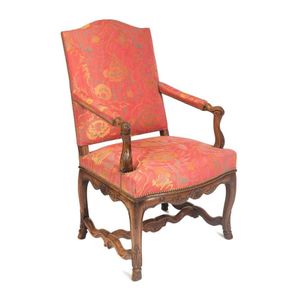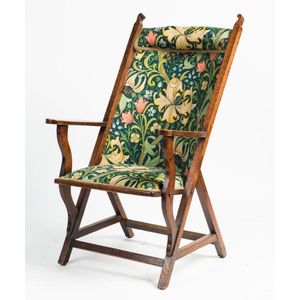Arts and Crafts Oak Armchair with Morris Fabric Upholstery
You must be a subscriber, and be logged in to view price and dealer details.
Subscribe Now to view actual auction price for this item
When you subscribe, you have the option of setting the currency in which to display prices to $Au, $US, $NZ or Stg.
- Oak - Native to Europe and England, oak has been used for joinery, furniture and building since the beginning of the medieval civilisation. It is a pale yellow in colour when freshly cut and darkens with age to a mid brown colour.
Oak as a furniture timber was superceded by walnut in the 17th century, and in the 18th century by mahogany,
Semi-fossilised bog oak is black in colour, and is found in peat bogs where the trees have fallen and been preserved from decay by the bog. It is used for jewellery and small carved trinkets.
Pollard oak is taken from an oak that has been regularly pollarded, that is the upper branches have been removed at the top of the trunk, result that new branches would appear, and over time the top would become ball-like. . When harvested and sawn, the timber displays a continuous surface of knotty circles. The timber was scarce and expensive and was used in more expensive pieces of furniture in the Regency and Victorian periods. - Morris, William - William Morris (1834 - 1896) an architect designer, artist, writer, poet and social activist is regarded as a leader of the Arts & Crafts movement in England.
After studying theology, ecclesiastical history, medieval poetry and art at Oxford University, Morris began work with a firm of architects for a short period.
In 1861 he formed a company Morris Marshall, Faulkner & Co. was formed to design and produce wallpaper, carpets, tapestries and stained glass, and they initially secured ecclesiastical works, later extending to domestic assignments.
In 1874 he took sole control of the company, buying out the other partners, and renaming it Morris & Co.
The origins of his designs can be traced to medieval Gothic styles but his organic flower and bird motifs encouraged later artists to seek inspiration for their designs in nature. - Circa - A Latin term meaning 'about', often used in the antique trade to give an approximate date for the piece, usually considered to be five years on either side of the circa year. Thus, circa 1900 means the piece was made about 1900, probably between 1895 and 1905. The expression is sometimes abbreviated to c.1900.
- Art and Crafts Movement - The Arts and Crafts movement began in Britain around 1880 and quickly spread across America and Europe. The Movement took its name from the Arts and Crafts Exhibition Society, founded in London 1887. One of the most influential figures behind the Arts and Crafts movements was the designer and writer William Morris. The movement continued until about 1920 and was followed by the Art Deco movement.
This item has been included into following indexes:
-
chairs, singles / pairs / threes, style or period
- armchairs 1,732
- Arts & Crafts 58
- William IV 122
- chairs, singles / pairs / threes, timber - oak 488
- Morris, William (Morris & Co.) (England) - furniture, designers and makers 26
Visually similar items

Campaign chair, ebonised turned legs with gold finish decoration, tapestry upholstery, iron fittings

A Louis XV walnut and upholstered fauteuil, French, 18th century

A George III mahogany Gainsborough chair, English 18th century. 102 cm high 66 cm wide and 58 cm deep. Provenance: Private Collection, Melbourne

A pair of French 'Baronial' armchairs, curving and scrolling arms decorated with large carved ram's heads to each end, the chair back with carved lion's head terminals and small carved acanthus leaf corbels, turned fluted legs, with carved decoration to th
